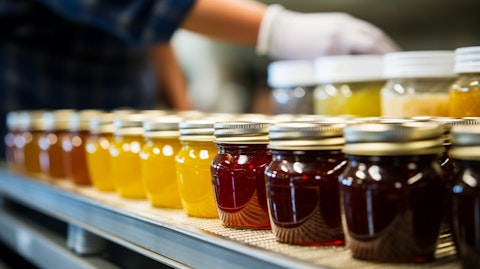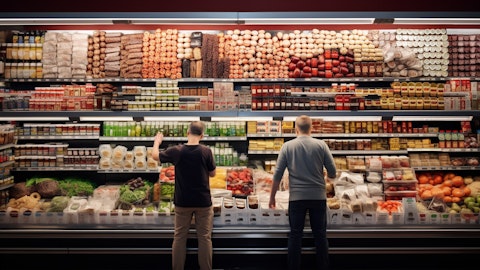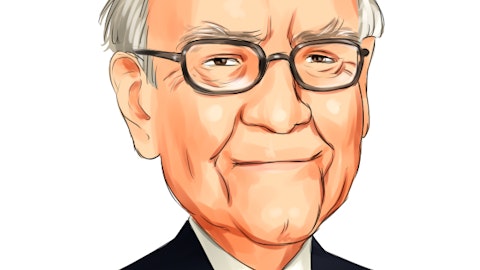The Kraft Heinz Company (NASDAQ:KHC) Q4 2023 Earnings Call Transcript February 14, 2024
The Kraft Heinz Company isn’t one of the 30 most popular stocks among hedge funds at the end of the third quarter (see the details here).
Operator: Good day and thank you for standing by. Welcome to the Kraft Heinz Company Fourth Results Conference Call. At this time all participants are in a listen-only mode. After the speakers’ presentation, there will be a question-and-answer session. [Operator Instructions] Please be advised that today’s conference is being recorded. I would now like to hand the conference over to your speaker today, Anne-Marie Megela, Head of Global Investor Relations.
Anne-Marie Megela: Thank you, and hello, everyone. This is Anne-Marie Megela, Head of Global Investor Relations at the Kraft Heinz Company and welcome to our Q&A session for our fourth quarter 2023 business update. During today’s call, we may make forward-looking statements regarding our expectations for the future, including items related to our business plans and expectations, strategy, efforts and investments and related timing and expected impacts. These statements are based on how we see things today, and actual results may differ materially due to risks and uncertainties. Please see the cautionary statements and risk factors contained in today’s earnings release, which accompanies this call as well as our most recent 10-K, 10-Q and 8-K filings for more information regarding these risks and uncertainties.

Additionally, we may refer to non-GAAP financial measures, which excludes certain items from our financial results reported in accordance with GAAP. Please refer to today’s earnings release and the non-GAAP information available on our website at ir.kraftheinzcompany.com, under News and Events, for a discussion of our non-financial measures and reconciliations to the comparable GAAP financial measures. Before we begin the Q&A session, it gives me great pleasure to hand it over to Carlos Abrams-Rivera for opening comments and to host his first earnings update as our Chief Executive Officer. Carlos, over to you.
Carlos Abrams-Rivera: Well, thank you, Anne-Marie, and thank you, everyone for joining us today. Before opening the call for questions, I just would like to say thank you to all my colleagues here at Kraft Heinz for delivering another solid 2023 results, and at the same time, making the strategic investment for the future. And frankly, all that while navigating some persistent industry pressures. I am very enthusiastic for our next chapter here at Kraft Heinz. And in 2024, we expect to drive top line growth, return to positive volumes, expand gross margins and operating margins and continue to reinvest in the business and an iconic brands. With that, I have Andre joining me today. Let’s open the call for the Q&A.
See also Top 20 Chocolate Companies in the World by Revenue and 30 Countries with Highest Standard of Living Ranked by GDP (PPP) Per Capita.
Q&A Session
Follow Kraft Heinz Co (NASDAQ:KHC)
Follow Kraft Heinz Co (NASDAQ:KHC)
Operator: Thank you. [Operator Instructions] One moment for questions. Our first question comes from Andrew Lazar with Barclays. You may proceed.
Andrew Lazar: Great. Thanks. Good morning, everybody.
Carlos Abrams-Rivera: Good morning.
Andre Maciel: Good morning.
Andrew Lazar: Carlos, I was hoping to start out maybe organic sales in the fourth quarter were impacted, as you talked about by trade timing and a retail inventory deload. You’re suggesting that you expect the first quarter organic sales to be similar to 4Q, which implies that underlying sales maybe could be a bit worse than 4Q. I don’t think you expect the retailer deload to continue. So, if I have that right, I guess, what would cause the sequential slowdown in organic sales in 1Q? And how do you see that playing out moving forward?
Carlos Abrams-Rivera: Yeah. Good question, Andrew. Thank you for that. The math on Q4 to Q1 may be similar, but the factors driving it are very, very different. I think maybe, Andre, if you can give a little more color as to the effects of both the North America business versus the emerging market business and how that’s shaping kind of the math behind the numbers?
Andre Maciel: Sure. Good morning, again, Andrew. So, we — as Carlos said, we do expect similar numbers from Q4, but coming from different drivers. So, on North America, we do expect better performance because we should not repeat both the trade timing and the inventory deload. We think we’re going to be at a healthy level at this point and sellout. If anything, maybe it will be in line or slightly better getting to Q1. Now when you talk about emerging markets, we do expect a shipment phasing that will affect Q1. So, we do expect, instead of growing double-digits like we have been doing consistently, emerging markets should be growing the mid single digit territory. You might remember that last year, we had a very strong performance in Latin America. Brazil grew 40% in Q1. So, we’re going to lap it that, but nothing wrong with the underlying sellout trends both in North America and emerging markets.
Andrew Lazar: Great. Really helpful. And then, Carlos, it seems — like if I have this right, most of the pressure in the GROW platform in the fourth quarter was in Easy Meals. If I had that right, can you talk a bit about what caused that, and maybe how this plays out as you move into the first quarter? Because it sounds like you do expect North America to get better.
Carlos Abrams-Rivera: Yeah. And frankly, Andrew, if I think about Q4 — let me start with some of the positive, which is we also saw the return to growth of our Ore-Ida business, driving both growth and share performance as we continue to leverage kind of the new partnership we have with our Simplot and really being able to service the business to its full potential. Now on the kind of headwind side, I think we saw some challenges in our mac & cheese business. Frankly, it’s a business that is driven disproportionately by our SNAP exposure. So that affected some of the business in Q4. However, as I think about going forward, there are three key things we’re doing to make sure we improve the trajectory: One, we’re also making — we are investing further in our new campaign behind mac & cheese and driving new innovation behind it as well.
So, you’ll see from us additional areas around bringing new SKU flavors. We’re bringing variety packs and we’re bringing, you may have seen a new plant-based option with mac & cheese in a partnership with NotCo. We’re also making sure we continue to drive even better value with mac & cheese by leveraging the fact that we have in our portfolio, partnership that we can do with brands like Oscar Mayer to offer truly a complete meal solution for consumers, plus offering multipacks around 12 packs and 4 packs in different formats to different types of consumers who are looking for value. And then finally, we’re also making sure we’re partnering with retails, we’re actually improving the overall assortment to optimize the traffic down the aisle. So, I feel very good about the fact that the team have been able to acknowledge what happen and taking — creating a new plan for us into ’24 to improve the performance of Easy Meals.
Andrew Lazar: Thanks so much and see you all next week.
Carlos Abrams-Rivera: Thank you.
Operator: Thank you. One moment for questions. Our next question comes from Bryan Spillane with Bank of America. You may proceed.
Bryan Spillane: Hey, thanks operator. Good morning everyone. I just had a — I have a question about Foodservice and maybe if you can just drill in a little bit. In North America, it decelerated relative to the previous quarters. And I think even in your slide, you’ve got underperformed relative to the industry. And so, I guess a couple of questions there. One is just is there a trade or an inventory deload happening in Foodservice. Maybe if you could talk a little bit about the respective channels within Foodservice, what got better and maybe what got worse? And then sort of your expectations, both for North America and global on Foodservice, do you expect it to be kind of in line with your algorithm for Foodservice this year or maybe even a touch better. Just want to unpack that Foodservice a little bit more, please.
Carlos Abrams-Rivera: Glad to. Let me start by clarifying something you said in your question. In our Foodservice business, we are growing both ahead of the industry in North America and International. So, I think that we actually feel very good about our performance on Foodservice, and we see that as we go forward into 2024. So, we see Foodservice growing up — growing in 2024 in our long — appropriate with our long-term guidance. So high single digits. So, we think actually it’s going to be a continued driver of our performance as we go into 2024. And frankly, we see that us having even more coming as we go forward because we are not only performing well where we are, but we also are improving by getting into new higher margin channels like independent and non-commercial channels, plus driving big innovation, leveraging our technology, leveraging the iconic brands that we have.
So until now, we have seen the beginning of the potential of Foodservice and that is actually driving faster growth than we have seen in the industry. And we actually believe that between the innovation that we have between us going into new channels that are higher margin and more attractive, we can actually make that even a faster growing part of our portfolio as we go forward.
Bryan Spillane: I guess if I’m looking at slide nine correctly, I think you’ve got the industry growing faster than your North America business in the fourth quarter. So, again, it just seems like — I don’t know if there’s a disconnect between what you shipped versus what consumption was. But — again, unless I’m looking at this slide incorrectly, it actually looks like you underperformed the industry.
Carlos Abrams-Rivera: Let me just say, I think you are looking at the slide incorrectly, and happy to follow up with you …
Bryan Spillane: Okay. Okay. All right. Thank you.
Carlos Abrams-Rivera: Thank you.
Operator: Thank you. One moment for questions. Our next question comes from Stephen Powers with Deutsche Bank. You may proceed.
Stephen Powers: Hey, thanks. Good morning, everybody.
Carlos Abrams-Rivera: Good morning.
Stephen Powers: Carlos, I guess stepping back, I’d just like a little bit more detail on your conviction surrounding improve total portfolio volume trends and presumably volume share trends and a return to growth as you progress through ’24. Because on the one hand, I understand drivers that you talked about in your prepared remarks. On the other hand, we’re coming off a quarter that saw you tweak organic growth expectations lower coming into the quarter and then effectively undershoot those expectations when the dust settled. So, I guess, again, what gives you the confidence that we’re not only leveling off, but we’re approaching a level that where we can return to growth without, I guess, incremental investment in promotions and price because it doesn’t seem like that’s part of the outlook.
Carlos Abrams-Rivera: Right. Let me just — let me unpack that a little bit. First, as you — as Andre mentioned earlier, there is some factors specifically affecting our Q4 performance in terms of trade as well as inventory that we’re not going to repeat as we go forward. As we go into 2024, if I think about, first, the top line, we are going to continue the progression of emerging market at Foodservice. And then emerging markets already growing volume. We have seen the progress of our Foodservice business growing faster than the industry. And in North America on the top line, we actually expect to recover share as we are now making all the payoff of the innovation investments we have made, we’ll start seeing that coming throughout the year.
So I think that idea of us continue to invest in the right things behind our insights in North America, it’s paying out with innovation. And then it also to have the right business plans with our retailers. Those factors actually are going to help us drive the top line with confidence. If I think about kind of the — specifically, you talked about volume. One of the things that we are looking at is we are anticipating a return to the historical activity levels. And in fact, we are seeing that already. So, we are expecting volumes to turn positive in the second half in the year because as I mentioned, the idea of us continue to invest in innovation that actually will give us the right tailwinds as we go into the year, plus we no longer will have some headwinds associated with both pricing that we took in Q1 of last year as well as the SNAP benefits cycling that as we go into the second half of the year.
So that also — that all together gives me the confidence that we can see that us coming together with a better performance we’re going to ’24 in a way that actually allows us to exit the year in an algo for us as a company.
Stephen Powers: Okay. Okay. Very good. Very good. Thank you. And then Andre, if I could, there was — the free cash flow conversion this year improved as it was expected to. So that’s a positive. I guess, just as we look into ’24, how are you thinking about free cash flow conversion in the New Year. Can we expect further improvements? And if not, either way, I guess, what are the drivers of free cash flow progress as we go forward? Thank you.




